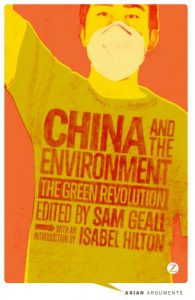At first glance Yang’s works appear idyllic landscapes, reminiscent of Song dynasty landscape paintings. Viewed up close, however, the peaceful mountains dotted with craggy pine trees dissolve into electricity pylons, dense layers of concrete buildings, cranes and neon lights.
Born in Shanghai in 1980, Yang studied calligraphy and traditional painting at school. Later he began to experiment with photography, video and contemporary ink painting to document China’s rapidly-changing landscape.
The images above scarcely convey the detail in these pieces, but they give a sense of Yang’s work. His pictures are beautiful and repulsive, mysterious and threatening. They invite thoughts of nature, individuality, the darker side of our relationship with the environment, and raise questions about the destiny of modern cities in China.
Yang talked to chinadialogue about his current exhibition at the Galerie Paris-Beijing in Paris and the inspiration behind his work.
Beth Walker: Your landscapes are both alluring and threatening; are they a criticism of the environmental destruction caused by rapid industrial growth?
Yang Yongliang: Our society is already ugly and horrifying enough, so I don’t want just to express that directly. I revere traditional Chinese philosophy, so I will be critical of environmental damage to a certain extent. I haven’t gone out of my way to express or highlight that theme; I just express what I feel through my works.
BW: How has growing up in Shanghai shaped your work?
YY: I live in Shanghai, a rapidly-developing city and in recent years have seen enormous growth and changes in the appearance of the city. I was born outside Shanghai, in Jiading – a place much older than Shanghai, a cultural centre of the Southern Song dynasty. But it is completely different now from my childhood memories. The ancient relics and architectural characteristics are virtually non-existent. It has changed into yet another uniform Shanghai suburb.
A culture and history has been erased by the modern, while foolish and entirely unprincipled efforts are made to restore the traditional. An ancient Song brick-built pagoda was “restored” with arched eaves and white walls, like something from Japan. Anyone with a conscience must be pained by this. And this is happening constantly all over China. We’re castrating our own culture for higher GDP and economic growth.
So everywhere we see nature ruined and replaced with identical skyscrapers and apartment complexes. It is natural that this kind of repetitive urban construction will be criticised.
BW: What role does traditional culture play in contemporary life?
YY: Traditional culture and Chinese society are moving ever further apart. Contemporary culture is moving towards a kind of distorted diversity, as people of different ages have had vastly different educations. What we can be sure of is that we are getting further and further from our traditions. Those traditions are now just heritage.
BW: Traditional Chinese culture supposedly protects nature, but this is not what we see today. What is the role of nature in culture?
YY: Yes, in ancient China there was respect for the harmony between man and nature. That really is the very core of ancient Chinese civilisation. But the Cultural Revolution virtually severed all links with that tradition. We were moving towards a false utopia, an illusion which ended with reform and opening up 20 years ago. China’s social development copies that of the early West. So China’s ancient beliefs of harmony are almost non-existent today. Unfettered development is increasingly straining the relationship between man and nature.
BW: Do you think that artists can raise awareness of the environmental problems we face?
YY: I think art can only stimulate and arouse something that already exists within you. It cannot change your basic views.
BW: What do you think Chinese cities will look like in the future?
YY: It’s hard to imagine, but it doesn’t look like development is slowing down.
The three collections Silent Valley, Moonlight and a Bowl of Taipei are on display in Galerie Paris-Beijing, in Paris until 11 May 2013.
All images courtesy of the gallery.






